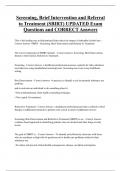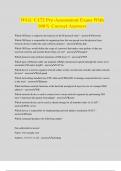9/2/24, 4:49 AM
D393 History of Healthcare in America - Section 1 Lessons
1-3
Jeremiah
Terms in this set (77)
Charitable social welfare, primarily for the poor, Pesthouses used for isolating
Key characteristics of Pesthouses and
contagious diseases, staffed by religious orders with little healing knowledge or
Almshouses (1700s-mid 1800s)
training
Key characteristsis of Community Hospitals Privately owned, supported by private donors
(Mid 1800s)
Characteristics of the emergence of medical Advanced with medical discovery and technology, new medical advances such as
practice in hospital setting (late 1800s) sterile technique, labs, and xrays, focused on treatment with expectation of care
Characteristics of proprietary hospitals ( late Largely focused on more affluent patients with ability to pay, Owned by physicians
1800s)
Formal affiliations with universities
Characteristics of the university based
Facilitation of research
medical center (early 1900s)
Education provided and promoted more well trained professionals
Integration of a wide range of medical services
Characteristics of the modern healthcare
Common organization
system (late 1900s to present)
Longitudinal care to wide demographic
Research and scientific knowledge
Medical Education and Licensing
Historical Healthcare Development Cycle Institutional Development
Physician's professionalization
Application of technology
The development of the modern US Johns Hopkins University, Mayo Clinic, American Medical Association, and William
healthcare system was heavily influenced by Osler, William Welch, Mayo brothers, and Abraham Flexner.
Founded in Baltimore in 1876 before the Hospital opened in 1889, and then The Johns
Johns Hopkins University
Hopkins School of Medicine, in 1893.
D393 History of Healthcare in America - Section 1 Lessons 1-3
1/6
, 9/2/24, 4:49 AM
- Established entrance requirements for medical students
- Developed a medical curriculum with emphasis on scientific method
How was Johns Hopkins University unique? - Incorporated bedside teaching and laboratory research as part of the curriculum
- First major medical school to admit women
-First to use rubber gloves, perform renal dialysis, and to perform CPR
an accumulation of public trust that leads to a sense of legitimacy, the granting of
What is cultural authority?
relative autonomy and the ability to self-regulate
Upgrading of medical schools
Relieved intense competition by reducing number of people who could practice
What did medical practice acts lead to? medicine
Addressed medical education, requirements of medical practice, and healthcare
regulation.
1 of 4 founding fathers of Johns Hopkins Hospital. He created first residency program
What did William Osler do? for physicians training in specialties and brought med students bedside for training, and
was one of the first professors of medicine
Was not a physician but was educated in natural sciences at Johns Hopkins, interested
in medical education. He was asked by AMA to conduct a survey for Council on
What did Abraham Flexner do? Medical Education (CME). His report found the US had too many medical schools and
physicians, called for restructuring medical education, consolidation of medical
institutions, and greater standardization of curricula to create a scientific
Report by Abraham Flexner by the Carnegie Commission to evaluate medical schools
Outlined the inadequacies of medical schools - called for standardization of curricula,
medical education, and research
What is the Flexner Report?
Caused schools that did not use this scientific model to close from lack of funding
Discouraged homeopathy and alternative forms of medicine despite being widely
practiced at the time
A physician and founding professor at Johns Hopkins Hospital. Promoted a more
What did William Welch do? clinical approach to medical education, emphasizing bedside teaching and
standardized clinical observation.
Founding in 1847 with the goals of advancing science, supporting medical education,
upholding medical ethics, and improving public health. Provided background material
American Medical Association (AMA)
that Flexner used in his report and provided a basis for medical licensing and
accreditation of medical education.
Founded the Mayo Clinic in 1889, after joining the small for-profit practice started by
Mayo Brothers (William, James, and Charles)
their father William Worrall Mayo, in Rochester, Minnesota.
World-renowned medical center focused on clinical excellence, research, and
application of that research to patient care, use of sterile technique, clear organization,
Mayo Clinic and collaborative group practice. It was one of the first healthcare organizations to
integrate the application of evidence-based medicine by incorporating data collected
and analyzed from its research.
Where would a poor individual with the Pest House 3 multiple choice options
plague receive treatment in the the early
1700s?
Which facility is credited as being the first Pennsylvania Hospital 3 multiple choice options
public hospital in the United States?
What year did medical specialization 1830
become common practice?
What year was the American Medical 1847
Association (AMA) founded?
D393 History of Healthcare in America - Section 1 Lessons 1-3
2/6







